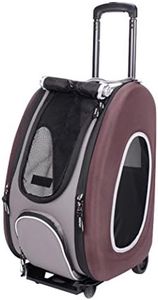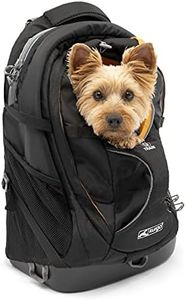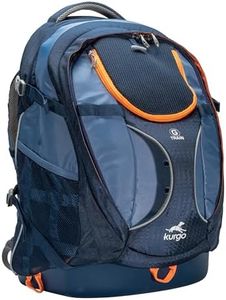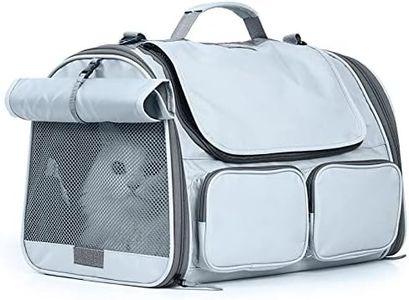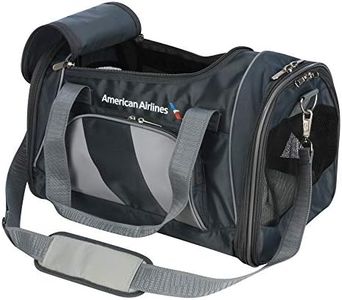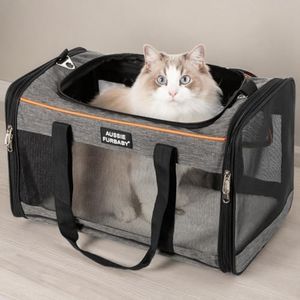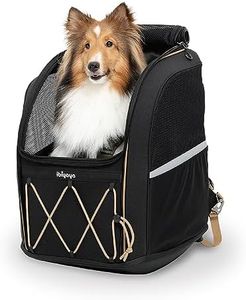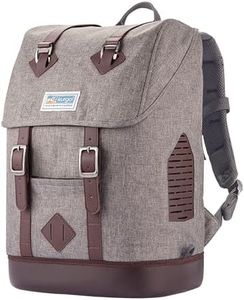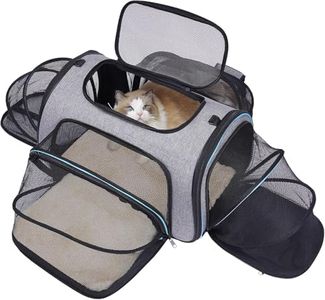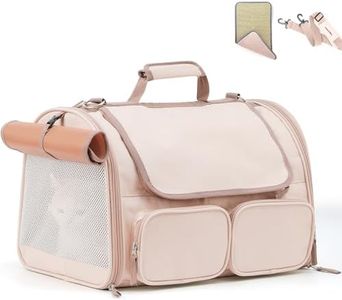We Use CookiesWe use cookies to enhance the security, performance,
functionality and for analytical and promotional activities. By continuing to browse this site you
are agreeing to our privacy policy
10 Best Airline Dog Carrier
From leading brands and best sellers available on the web.Buying Guide for the Best Airline Dog Carrier
Choosing the right airline dog carrier is an important step when you want to travel safely and comfortably with your pet. Different airlines may have specific requirements, but your main goal is always to ensure your dog’s safety, comfort, and security throughout the journey. When shopping for an airline dog carrier, think about your dog’s size, temperament, and how long you’ll be traveling. Also, always check the airline's specific rules before making a purchase, as not all carriers are universally accepted.Carrier SizeCarrier size refers to the overall dimensions of the carrier. It’s crucial because your dog should have enough room to stand up, turn around, and lie down comfortably, but the carrier must also fit under the seat in front of you if you're traveling in-cabin. Sizes usually range from small to large, and many brands specify the weight or measurements each is suitable for. To navigate these options, measure your dog’s length, height, and weight, then compare them to the carrier specifications. Choose a size that gives a little extra room but isn’t so big that your dog feels insecure or the carrier becomes unwieldy.
VentilationVentilation refers to how well air circulates inside the carrier. Good airflow is essential to keep your dog comfortable and safe, preventing overheating or stress. Carriers feature ventilation through mesh sides, air holes, or windows. Some have ventilation on one side, while others offer it on three or even all sides. Ideally, pick a carrier with at least two sides of ventilation, but if your trip will be long or your dog gets anxious, go for as much ventilation as possible.
Material and Build QualityMaterial and build quality describe what the carrier is made of and how sturdy it is. This matters because a strong, durable carrier withstands travel rigors, keeps your pet secure, and complies with airline requirements. Carriers are generally made from soft-sided fabrics or hard plastic. Soft-sided carriers are lighter and more flexible (helpful for in-cabin travel), while hard-sided carriers offer more protection, especially for cargo. If your dog is calm and you are flying in-cabin, soft-sided models may be fine; if your dog is energetic or you'll be checking the carrier, a sturdy, hard-sided option is safer.
Entry PointsEntry points refer to the doors or openings through which your dog gets in and out of the carrier. Some carriers have a single entry on one end, while others have multiple entry points, such as a top and a side. Multiple openings can make loading easier, especially if your dog is nervous or reluctant to enter. If your dog is calm and used to carriers, a single entry may be enough; for anxious or larger dogs, a top-loading option often simplifies things.
Security FeaturesSecurity features include the zippers, locks, fasteners, and whether the door is escape-proof. This is important because you want your dog to stay safely contained but also be easy for you to access. Some carriers have double zippers, locking mechanisms, or clips to prevent accidental opening. If your dog is an escape artist or gets nervous, pay extra attention to how securely the carrier can be closed.
Comfort FeaturesComfort features include padded floors, soft bedding, and interior space for your dog's relaxation. These matter for longer trips or if your dog is sensitive to new environments. Some carriers come with removable, washable mats, while others are more basic. If you know your dog enjoys cozy, padded spaces, select a carrier with extra comfort touches. If you plan frequent, shorter trips, basic comfort might be enough.
PortabilityPortability refers to how easy it is to carry and handle the carrier. This is influenced by features like a shoulder strap, handles, or even wheels. Lighter, soft-sided carriers usually have more portability features, while larger, hard-sided models may just have a single handle. If you anticipate carrying the carrier long distances through airports or stations, look for added straps or wheels; for short distances, basic handles are sufficient.
Airline ApprovalAirline approval means whether the carrier meets the size, ventilation, and build rules set by most airlines. Not all carriers labeled as 'airline approved' will fit every airline, so always check your airline’s guidelines before buying. Choose a carrier that clearly specifies airline compliance, and when in doubt, measure the carrier and verify with your airline to avoid last-minute issues.
